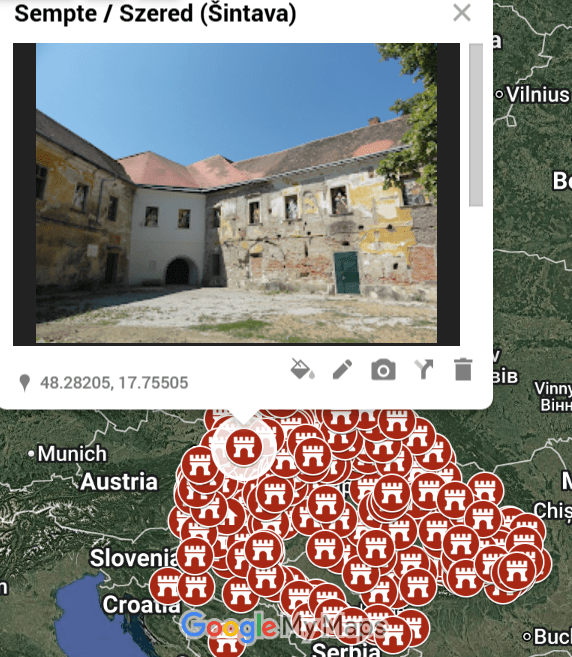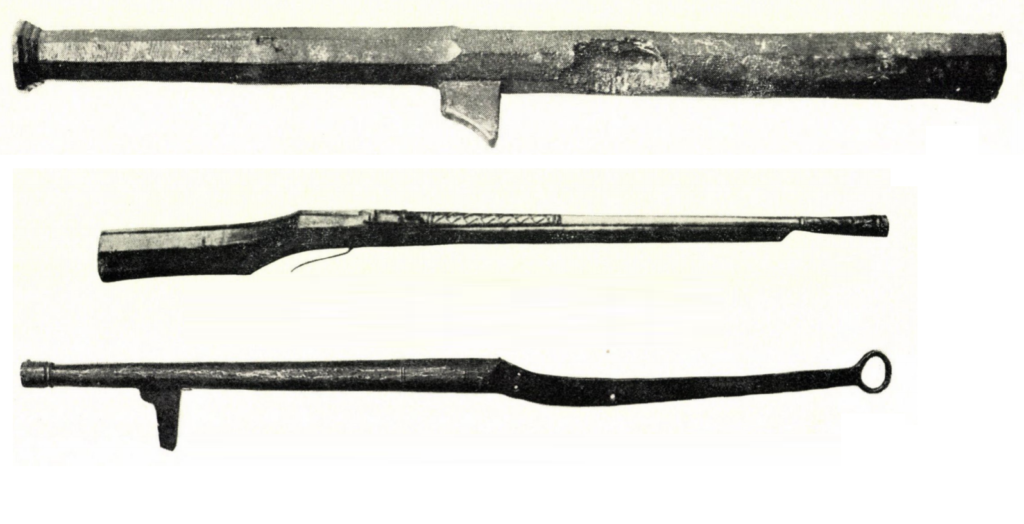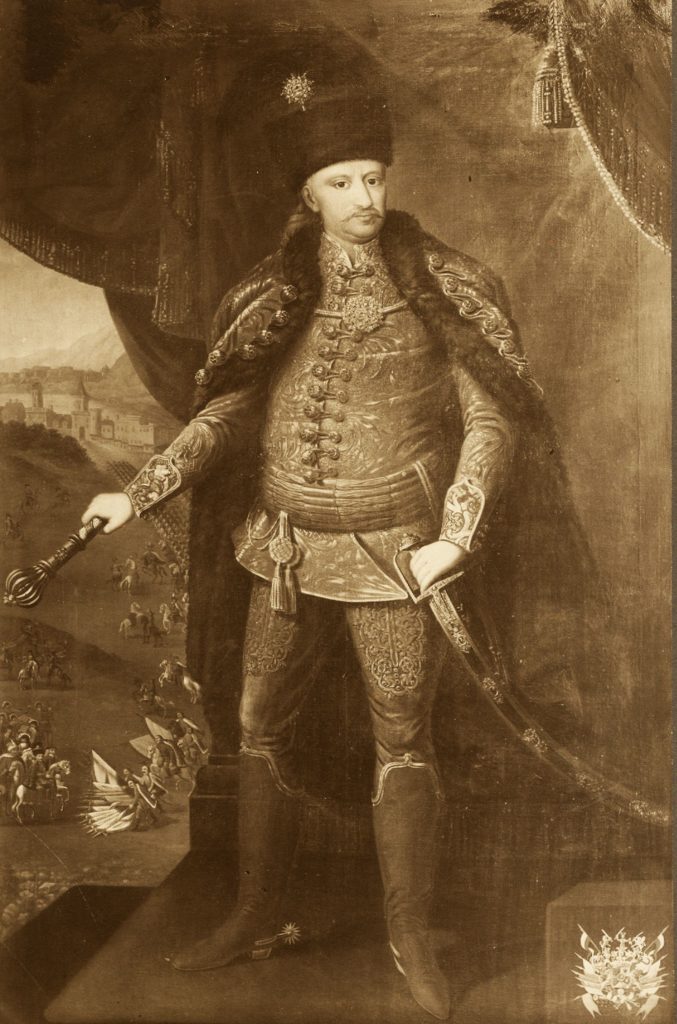
The heavily modified present-day form of Szered Castle is located near Sempte (Šintava) in Slovakia, but the castle was built in the Kingdom of Hungary. It is unfortunate how the castle looks today in the otherwise beautiful park of such a large city. Location: https://tinyurl.com/bm2n3pwb

The town of Szered owes its existence to the Vág, one of the most important rivers in the Highlands Region of the Kingdom of Hungary (Felvidék). In the distant past, the Vág was not as regulated as it is today. When it reached the plains, the river formed islands surrounded by marshy areas. As early as the 9th century, there was a castle on one of these islands, which served as a border defense.

In the Middle Ages, wooden bridges were built to replace the old fords, connecting the main islands. The largest island was home to the 10th-century castle of Sempte, built of wood and earth. The settlement near the castle first appeared in written sources in 1313 under the name Zereth.

The name of the market town that developed next to the castle was transferred to the castle itself in the 16th century. The importance of Szered, located on the border between the counties of Nyitra and Pozsony, was further enhanced by the fact that the trade route from Buda to Prague passed through here. A commercial center soon developed here at the Vág crossing, whose animal and grain markets were famous far and wide. Wood and salt shipments floated down the Vág on rafts and also arrived here, and the town had a salt warehouse and ship mills operating on the river.

Sempte Castle was certainly the center of one of the early medieval counties and probably already existed in the 11th century. According to Győrffy György, it was built by Saint István after 1018 as part of the defenses against King Bolesław I of Poland and the Czechs. What is certain is that our ancestors settled here at the beginning of the 10th century, as evidenced by the six cemeteries found in the area. The Vág River could be crossed most easily here, and this was certainly not left unguarded. The name Sempte can also be traced back to the Hungarian personal name Sümpte. Although the castle is now located on the right bank of the Vág, it used to be on the left bank, but was moved to the other side due to changes in the riverbed.

The Chronicon Pictum mentioned Sempte in Emperor Henry IV’s and the exiled King Salamon’s campaign of 1074: “When the Emperor reached the Vág River, Salamon received three battalions and rode from Sempte towards Nyitra.” Szemere, a castellan of Sempte, was first mentioned around 1177. In 1221, the Váradi Regestrum mentioned the names of 12 serfs of Sempte (“Joubagiones castri Sumptey”). In 1233, a document referred to it as castri de Scemte, mentioning “curialis comes” and Péter, son of Csépe, Vice Comes.

The importance of the Sempte castle district gradually declined after the Mongol invasion. In 1261, King Béla IV granted it to his vassal Trusleph, and upon his death, to his brother Liupold (“quod sicnt fideli nostro Trusleph Comitatum de Sciuptey contuleramus, sic eciam post mortem eiusdem Trusleph aduertendo fidelitatem suam et eciam seruicia fidelia, que frater suus Lyuppoldus vna cum fratre suo Petro nostre Maiestati exhibuerant indefesse, dictum Comitatum cum omnibus appeudiciis et vtilitatibus eiusdem ipsi Lyuppoldo Comiti de nostro beneplacito duximus conferendum.”). At the same time, he removed them from the authority of the chief Comes of Pozsony and Nyitra.

Although King László IV briefly revived the Sempte castellany in 1275, Tamás, a member of the Hontpázmány clan, was also the castellan of Pozsony County and Sempte. The castellany ceased to exist after the 1270s, and its castle estates were transferred to the administration of neighboring counties.

The early castle was built on an island approximately 25-35 meters in size, surrounded by branches of the Vág River. Its oldest identifiable element was the 12th-century-old tower, built of brick and measuring 12 x 12 meters, with walls up to 2.6 meters thick. A moat was connected to its western side, while a short fragment of a stone wall was discovered on the eastern side. In the 13th century, a 36 x 36-meter square wall was built 8-14 meters from the tower. The entrance was on the northern side. The whole structure was surrounded by an earthwork, a palisade, and a moat.

At the beginning of the 14th century, Sempte belonged to Aba of the Aba clan, but when he fell in battle against King Károly I in 1312, it was taken over by Csák Máté. After the death of Csák Máté (1321), Sempte became a royal castle, which was given to Count Vörös Ábrahám by King Károly I. In 1323, the king gave Cseklész to Ábrahám in exchange for Sempte (“Scemtey”) (“… Since the king considered the two estates important to himself, he took them away from Ábrahám and in exchange granted him the Cheklyz estate with the castle of Cheklyz and all its possessions…”).

In 1326, King Károly I appointed Zách Felicián as castellan of Sempte, but two years later, he removed him from office. Perhaps this fall from grace played a role in the attempted assassination of the royal family by Zách Felicián in Visegrád on April 17, 1330.

Between 1341 and 1349, Raholci Tót Lőrinc, the Comes of Nitra and royal standard-bearer, received Sempte from the king as an honorary estate, of which he had previously been the castellan (* mentioned in a document from 1328). In 1381, János, son of János, was the royal castellan of the castles of Sempte and Vöröskő.

In 1385, at the beginning of his struggle for the Hungarian crown, Zsigmond of Luxembourg pledged the territory to his cousins, the Moravian margraves Jodok and Prokop, up to the Vág River. According to the agreement, Queen Mary was to repay 200,000 forints, one of the locations being Sempte. Zsigmond negotiated twice with his cousins in Sempte about the return of the territories (May 1387, May 1388). In 1390, he finally recaptured some of the occupied castles with a military campaign.

Between 1410 and 1419, the Polish Mościc of Stęszew, castellan of Poznań and envoy of King Władysław of Poland, received it as a pledge from Zsigmond of Luxembourg for 9,217 forints. Mościc was a relative of Stibor, also of Polish origin, who was one of Zsigmond’s most trusted men and military commanders. In 1420, with the king’s permission, Mościc pledged the estate to Bazini György for 10,500 forints.

In 1423, an inventory was made of the castle due to property disputes. The nearly square castle was surrounded by a double wall and had two gates protected by towers. The old tower stood in the middle of the castle, and the buildings of the inner castle were located along the southern and northern walls. The castle chapel was dedicated to St. Margaret. In 1424, King Zsigmond took back Sempte from Bazini György and pledged him the castle of Szaplonca in return.

In 1426, the Archbishop of Esztergom, Pálóczi György, and his brothers, Máté and Imre, received Sempte as a pledge (“maiestati nostre acommodarunt et nomine certi mutui ac sub spe restitucionis dederunt […]; nos volentes eosdem […] de rehibitione huiusmodi summe floreni certos reddere et securos castrum nostrum Sempte appellatum […] pignori duximus obligandum ymo impignoramus”). The Pálóczi brothers acquired it as a perpetual gift in 1427, but in 1429, they exchanged it with King Zsigmond for the castle of Újhely, together with the castle of Szakalya in Sáros County.

On May 9, 1430, King Zsigmond issued a letter in Sempte instructing the chief Comes of Sopron, Kanizsai László, to send his own troops and those of the nobles without delay to Sempte (“Sempthe”) and Trencsén to guard the Vág Valley against the Bohemian Hussites. In the same year, Rozgonyi István and Gyögy, the two Comes of Pozsony, received the estate as a pledge.

In a document dated March 31, 1438, King Albert granted Rozgonyi Simon, Bishop of Veszprém and Royal Chancellor of the Queen, as well as Rozgonyi Simon’s sons, István and György, Counts of Pozsony, and their male descendants, the castle of Sempthe in Pozsony County, which was in their possession as a pledge, along with its belongings. If the heirs die without male descendants, the estate can be redeemed for the amount of the pledge.

On September 21, 1446, before the Buda Chapter, György, son of the late Rozgonyi Simon, Comes of Pozsony, and Rozgonyi Sebestyén, their relative, agreed with János, son of Rozgonyi István, to divide their inheritance: Csókakő (Chokakeö) Castle would go to János, while Sempthe would go to György and Sebestyén. In the summer of 1450, Ludányi György invaded Rozgonyi’s estate with “the Czechs and other foreigners” and robbed and burned down Szered, which belonged to Sempte Castle. The damage amounted to 4,000 forints. In 1456, the Germans of Éleskő Castle plundered Szered.

In the summer of 1490, Rozgonyi László hosted King Ulászló II in Sempte, who had been elected by the Diet two weeks earlier. On June 21, 1491, with the consent of King Ulászló II, Rozgonyi László left the castle and estate of Sempte to his wife and daughters. Rozgonyi died in 1492 and was succeeded by his wife, Bánffy Erzsébet of Alsólindva, who married Kanizsai György (* 1492). According to a 1502 document, Kanizsai held the castle as a pledge.

In 1530, King Ferdinand I granted Sempte to Turzó Elek, and after he died in 1543, it passed to his daughter, Thurzó Anna, who married Báthory András. Báthory rebuilt the castle in 1543 and owned it until he died in 1566. A legal battle began over Sempte, which was given to Count Julius Salm and his wife, Thurzó Erzsébet, by King Ferdinand I in the mid-16th century. In the 1570s, Bornemissza Péter, a Lutheran pastor and tutor to Balassi Bálint, lived and printed his works here.

After Count Salm’s death, a renewed legal battle began over Sempté, which was finally seized by force by the Thurzó family in 1596. Thurzó Szaniszló immediately began upgrading the castle. A new defensive belt was built around the castle, with pentagonal bastions at the corners suitable for artillery. A wide moat was dug around the castle, and two outer earthworks were also built.

A document dated May 11, 1605, contains provisions regarding the assignment of the castle guard:
“1. His Excellency will be accompanied on the stone bastion by Lord Keresztúri András, Lord Semberi Pál, Lord Vitéz Imre, Lord Baranyai Tamás, Lord Ocskay Imre, Lord Tessényi György, Lord Bori János, Lord Tani Ferencz, Lord Fekete János, Lord Beke Tamás, Lord Pribék Jakab, and a ten drabants. Next to Pográni István on the oven house bastion, thirteen nobles, two servants, and ten foot soldiers. 3. Farkas György on the blacksmith’s bastion, twelve nobles and ten foot soldiers. 4. In the bastion of Szerdahelyi János, fourteen nobles and ten drabants. 5. In the tower, five nobles, two castle drabants, and one tenth of the drabant. 6. In the inner castle, six nobles and ten guards. Eleven coachmen and drivers, wherever needed, should be on the bastion near the gate.”

Sempte opened its gates to Bocskai’s troops without a fight. In 1619, during the first campaign of Prince Bethlen Gábor, Thurzó Szaniszló reluctantly switched sides to Bethlen. In October 1619, Bethlen’s army, which was marching on Pozsony, defeated the Imperial army of Teuffenbach at Szempc. Some of the cannons captured here were sent to Érsekújvár and Sempte.

In 1620, Thurzó Szaniszló issued instructions in case of siege: “1. The location of the cannons must be adjusted on the bastions. 2. The people needed for the cannons, gunpowder, bullets, fuses, and other necessary items must be in place. 3. The captains and officers shall go up to the bastions. 4. Two officers shall go up to the tower with 14 men who are accustomed to using cannons. Bearded rifles, gunpowder, and bullets are also required. 5. The lieutenants shall stand on the four bastions and towers. 6. A lieutenant should stand in the castle courtyard with the reserve team. 7. Before and after midnight, there should be two patrols on the walls under the supervision of the sergeant. 8. One team should be ready to break out.

According to a letter written by Bethlen Gábor to Thurzó Imre on April 22, 1621, he sent 3,000 men to Érsekújvár and 500 to Sempte. At that time, Thurzó Szaniszló was in command at Érsekújvár and Sempte, the latter of which was also his estate. Bethlen was suspicious of Thurzó, so he sent troops to Sempte, but the castle captain, Balogh Ferenc, remained one of Thurzó’s men. Although Sempte was one of the best fortified and supplied castles at the time, its garrison did not prevent the Imperial army from crossing in May 1621 when they set out to recapture Érsekújvár. Bethlen later wrote contemptuously about the cowardice of the garrison.

After the conclusion of the Peace of Nikolsburg, Bethlen withdrew his troops from Sempte, and on February 24, 1622, the castle was handed over to Thurzó’s man, Ernyő Lukács, the castellan. An inventory was also made at this time. It mentioned two old flags, one of which Thurzó Szaniszló “carried in battle under Canisa and Fejérvár,” and another, the flag of Hungary, “which His Majesty carried at the coronation of King Matthias [* Matthias II].” At that time, the castle had “150 musket rifles, 64 Moravian steel rifles, 56 rifles for Hajdú soldiers, 34 old bearded ones without iron (hook guns), 22 small bearded ones, 11 long janissary rifles, and Mrs. Rottál’s rifles.” According to the inventory, Sempte was well supplied with artillery equipment and ammunition.

After the Thurzó family died out, on August 30, 1636, King Ferdinand III sent a stern order to Berényi György, captain of the castle of Sempte, to immediately surrender Sempte, the castle of Temetvény, and the other estates. Between 1639 and 1642, Palatine Esterházy Miklós lived here with his wife, Nyáry Krisztina, who died here in 1641. The reconstruction of Sempte was begun by the palatine: the moat was cleared, and a two-story palace was built on the south and west sides of the castle. Payments for the construction were made by Esterházy Pál, who was also the guardian of his younger brother Ferenc. He leased Sempte to Farkas Esterházy for four years on October 30, 1654. In 1660, Esterházy Pál and Ferenc divided the estates, and Ferenc received Sempte.

In 1663, war broke out again with the Ottomans. On September 27, 1663, the Turkish Grand Vizier captured Érsekújvár by siege, and in October, Turkish troops also laid siege to Sempte. The castle was defended by 500 Bavarians under the command of Lieutenant Colonel Nicola, and the defenders also had 40 cannons. Due to the heavy cannon fire, the Turks soon withdrew. In February 1664, Montecuccoli wrote to the Court Council that, according to the captain of Magyaróvár, the fortification works in Magyaróvár, Pozsony, and Sempte had been halted due to a lack of materials.

In 1664, when it became known that neither Érsekújvár nor Nagyvárad would be returned from the Turks under the terms of the Peace of Vasvár, the Hungarian estates were outraged. When, despite the protests of the counties, Emperor Leopold I offered to fortify one of the towns of Sempte, Farkashida, or Guta in place of Érsekújvár, with the counties bearing half of the costs, the estates of the realm responded with great indignation.

After the loss of Érsekújvár, Sempte was declared a border fortress, and the headquarters of the Mining Region Captaincy was moved here. The vice-captain of the fortress was appointed Gyöngyösi Nagy Ferenc, who held the position until 1671. In December 1668, the future Palatine Esterházy Pál was appointed captain-general of the Mining Region. In 1671, an engineer sent by the War Council to inspect Sempte found much that needed repair. The floor plan from 1672 clearly shows the castle reinforced with Italian bastions at its four corners.

In 1683, Thököly Imre occupied Sempte, appointing Szirmay Endre as its captain, who transported cannons from Pozsony to Sempte, reinforced the castle with wooden stakes, and built a bridge over the Vág River. After its defeat near Vienna, the Turkish army abandoned Sempte and transported the cannons to Kassa.

On December 2, 1703, the Kuruc troops of Károlyi Sándor captured Sempte without a fight. Esterházy Antal had already fled the castle days earlier and later joined Rákóczi’s side. On December 29, 1703, Bercsényi Miklós sent a letter from Sempte to Nógrád County, ordering the county infantry to be sent to Csábrág.

Sempte changed hands several times between 1704 and 1708. In May 1704, Bercsényi retreated to Óbars from the approaching Imperial troops of Heister and burned the bridge at Szered-Sempte on the Vág River. After Heister’s retreat, the Kuruc troops occupied Sempte again. On November 25, 1704, Prince Rákóczi II Ferenc wrote a letter from here. After the unfortunate battle of Nagyszombat (December 26, 1704), the prince moved his headquarters to Sempte and designated Sempte and Kistapolcsány as the assembly points for his troops.

During the peace negotiations in the spring of 1706, Prince Rákóczi was visited by his wife, Princess Amália Sarolta. The prince’s wife was received by Bercsényi in Sempte. The peace negotiations ended without result. Forgách set out from Sempte on October 4 to bombard Pozsony, but contrary to the prince’s orders, this did not happen, and Forgách instead invaded Moravian territory.

In the summer of 1707, General Guido von Starhemberg drove the Kuruc forces out of the area between the Morava and Vág rivers and, relying on the castles he had captured along the Vág, organized a line of fortifications (Komárom, Gúta, Galánta, Diószeg, Vágsellye, Sempte, Szered, Lipótvár, Csejte, Vágújhely, Beckó, Trencsén, and Illava). As the Imperial army approached, Esterházy Antal evacuated Sempte. Starhemberg secured a bridge over the Vág with the fortifications of Sempte and Szered to launch an operation against Nyitra, the siege of which began on August 24. Still, he soon had to retreat to Transdanubia due to Austrian attacks launched by Bottyán.

Esterházy Antal ordered Ocskay to recapture Sempte. On September 16, Bagossy Pál’s Hajdu soldiers captured the bridge at Szered and two defensive structures on the left bank in a bloody assault. On September 20, Bagossy reported that he had begun the bombardment of Szered (Sempte). Upon hearing this news, Starhemberg hurriedly set out from Pozsony and entered the castle of Szered on September 21. Esterházy then had the bridge over the Vág and the huge defensive structures surrounding it set on fire and demolished in full view of the Imperials.

After the defeat of the Rákóczi War of Independence (1711), Esterházy Antal emigrated, and Sempte was returned to the loyal members of the Habsburg family. In 1742, Bél Mátyás wrote that the fortifications and buildings of the castle were demolished by Esterházy József, and the remaining southern and western palaces were converted into a Baroque castle. The inner castle disappeared completely, and only the old tower remained. The moats of the castle were filled in, and a park was created.

In his book Picturesque Journey on the Vág River in Hungary (1825), Mednyánszky Alajos wrote the following about the castle in Szered:
“Surrounded by gardens and adapted to modern tastes, the castle building is topped by a thick, square tower, built from huge blocks of stone, the only remnant of the former fortification. … [After the Rákóczi War of Independence] Count Esterházy József, upon his return, had the damage repaired and at the same time had the extensive fortifications converted … All traces of the recent past that reminded people of the age of violence were erased, and the former gloomy castle was transformed into a tasteful manor house, peeking out from among groups of trees, giving little hint of what it once was.”
Mednyánszky also mentioned that the castle was originally located on the left bank of the Vág River.

In the 19th century, the remains of the old tower collapsed and had to be demolished (* the tower can still be seen in the landscape painting from 1820). The castle acquired its current form around 1840, when Esterházy Károly had it rebuilt in the classicist style. In 1849, the Austrian high command, stationed in the Esterházy castle in Szered, celebrated the news of the surrender at Világos with cannon fire.

The inventory of the castle, compiled in 1850 due to the financial difficulties of Esterházy Károly, is still known today. According to this, the castle had 64 rooms at that time and several representative salons: the Summer Salon, the Yellow Salon, and the Library Salon, which contained 1,032 books. The countess’s dressing room was black, and her bedroom was mahogany brown. The Silver Room was used to store crystal and silver cutlery. There was a games room, several guest rooms and bedrooms, as well as rooms for the servants.

In 1860, Angelique d’Alsace de Hénin de Brienen purchased the estate and castle as a summer residence. In 1912, Baron Ohrenstein became the owner, and after his death, his son György took over. However, due to the Treaty of Trianon, he did not take possession of the estate until 1925. As he was of Jewish descent, the fascist Slovak state took it away from him in 1941. In 1944, German soldiers were quartered there, and in 1945, Soviet soldiers. It was converted into a hospital, and the valuable wood was used for heating. In 1948, it became the property of the Czechoslovak state. It also housed a theater, a playhouse, and a wine bar.

The restoration of the castle began in 1984 under the leadership of Izsó József, and in the 1990s, the former foundation walls of the castle in the castle courtyard were excavated. Unfortunately, these are not visible today because they have been reburied. The castle is still in poor condition, but a civil association has begun its renovation (2024).

Source: Szöllősi Gábor, https://varlexikon.hu/sempte, and thanks to Lánczi Imrének, too.
Dear Readers, I can only make this content available through small donations or by selling my books or T-shirts.
Please, support me with a coffee here: https://www.buymeacoffee.com/duhoxoxa
You can check out my books on Amazon or Draft2Digital. They are available in hardcover, paperback, or ebook:
https://www.amazon.com/dp/198020490X or at https://books2read.com/b/boYd81

My work can also be followed and supported on Patreon: Become a Patron!http://Become a Patron!
Become a Patron! Donations can be sent by PayPal, too: https://tinyurl.com/yknsvbk7


https://hungarianottomanwars.myspreadshop.com/all
Subscribe to my newsletter here: https://tinyurl.com/4jdj
Here are more pictures of Sempte:














































